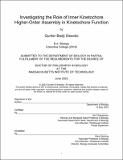| dc.description.abstract | Cells are the basic building blocks of life. As a result, every organism depends on cell division to survive and reproduce. To divide, eukaryotes use a genetic program called the cell cycle, which coordinates the steps required to grow a cell and divide its contents into two daughter cells. Each cycle, eukaryotic cells duplicate their genomes during Synthesis (S) phase and separate the two copies of the genome during Mitosis. To mechanically separate those copies, cellular structures undergo dramatic rearrangements. The genome is packaged into discrete chromosomes that can be manipulated easily. Simultaneously, microtubules reorganize into the mitotic spindle, which generates the forces that move chromosomes. To connect chromosomes to spindle microtubules, the cell builds protein complexes called “kinetochores” on regions of the chromosomes known as “centromeres.” The inner kinetochore resides on chromosomal DNA throughout the cell cycle. As mitosis approaches, post-translational modifications trigger recruitment of the outer kinetochore, which binds to microtubules and harnesses the forces they generate to move chromosomes.
To avoid DNA damage, most organisms assemble kinetochores at a single location on each chromosome that is designated by the histone H3 variant CENP-A. CENP-A nucleates kinetochore assembly at centromeres but also easily mislocalizes to non-centromeric DNA. Interestingly, non-centromeric CENP-A typically does not recruit kinetochores. Kinetochores only assemble at loci where there is a very high density of CENP-A nucleosomes. Consistently with that, imaging and the large copy numbers of kinetochore proteins at individual kinetochores suggest that inner kinetochore proteins form higher-order assemblies. These findings suggest that interactions between CENP-A-associated inner kinetochore modules have a role in proper kinetochore assembly. In my thesis work, I investigated how higher-order assembly of the inner kinetochore protein CENP-T, which recruits the outer kinetochore in vertebrates, impacts CENP-T’s function.
To test the impact of higher-order assembly on CENP-T, I used artificial oligomerization to generate CENP-T assemblies with different numbers of CENP-T molecules. With this approach, I generated kinetochore-like particles that recruit a complete complement of outer kinetochore proteins and interact with microtubules similarly to endogenous kinetochores. By comparing oligomers generated with two unrelated strategies to monomers, I found that CENP-T only robustly recruits the outer kinetochore when oligomerized. This behavior can be recapitulated in vitro with recombinant proteins and no other cellular factors. Furthermore, my results suggest that outer kinetochore recruitment increases gradually with the number of CENP-T molecules in an oligomer.
Our findings are some of the first direct evidence of the important role of inner kinetochore higher-order oligomerization in kinetochore function. They suggest that oligomerization of the inner kinetochore regulates where kinetochores assemble by restricting outer kinetochore recruitment to regions with a high density of inner kinetochore modules. This result opens the door to further work on the role of higher-order assembly at kinetochores. Furthermore, my work has revealed a method by which native kinetochore-like particles can be generated for in vitro biophysical analysis, and my artificial oligomerization approaches will be valuable for studying other pathways that involve higher-order assemblies. | |
